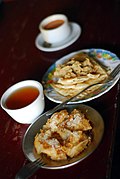Paratha
Paratha is a type of flatbread that originated in the Indian subcontinent. It is one of the most popular types of bread in the region and is a staple food in many households. Parathas are typically made from wheat flour, water, and ghee (clarified butter), but can also include other ingredients such as spices, vegetables, and meat.
History[edit]
The word "paratha" comes from the Sanskrit words "parat" and "atta", which together mean "layers of cooked dough". This refers to the method of making parathas, which involves folding the dough multiple times to create layers. Parathas have been a part of Indian cuisine for centuries, with references to similar types of breads found in ancient Sanskrit texts.
Preparation[edit]
To make a paratha, the dough is first prepared by mixing wheat flour with water and a small amount of salt. The dough is then divided into small balls, which are rolled out into thin circles. Ghee is spread on the surface of the dough, which is then folded and rolled out again to create layers. The paratha is then cooked on a tawa (flat griddle) until it is golden brown on both sides.
There are many variations of paratha, with different fillings and flavors. Some popular types include aloo paratha (potato-filled), paneer paratha (cottage cheese-filled), and methi paratha (fenugreek leaves-filled).
Consumption[edit]
Parathas are typically served hot and are often eaten with curry, pickle, yogurt, or butter. They are a common breakfast dish in many parts of the Indian subcontinent, but can also be eaten for lunch or dinner. In some regions, parathas are also served as a street food.
Cultural significance[edit]
Parathas hold a significant place in the culinary culture of the Indian subcontinent. They are often associated with comfort food and home cooking, and are a common feature in festive meals and celebrations.
-
Paratha
-
Parathas being made
-
Aloo Paratha with Butter from India
-
Mughlai Kheema Paratha
-
Dhakai Paratha with Bengal Gram
-
Paratha
-
Paratha
-
Paratha
-
Paratha
-
Paratha
-
Smash Paratha - Howrah
-
Lachha Paratha
Ad. Transform your life with W8MD's Budget GLP-1 injections from $75


W8MD offers a medical weight loss program to lose weight in Philadelphia. Our physician-supervised medical weight loss provides:
- Weight loss injections in NYC (generic and brand names):
- Zepbound / Mounjaro, Wegovy / Ozempic, Saxenda
- Most insurances accepted or discounted self-pay rates. We will obtain insurance prior authorizations if needed.
- Generic GLP1 weight loss injections from $75 for the starting dose.
- Also offer prescription weight loss medications including Phentermine, Qsymia, Diethylpropion, Contrave etc.
NYC weight loss doctor appointmentsNYC weight loss doctor appointments
Start your NYC weight loss journey today at our NYC medical weight loss and Philadelphia medical weight loss clinics.
- Call 718-946-5500 to lose weight in NYC or for medical weight loss in Philadelphia 215-676-2334.
- Tags:NYC medical weight loss, Philadelphia lose weight Zepbound NYC, Budget GLP1 weight loss injections, Wegovy Philadelphia, Wegovy NYC, Philadelphia medical weight loss, Brookly weight loss and Wegovy NYC
|
WikiMD's Wellness Encyclopedia |
| Let Food Be Thy Medicine Medicine Thy Food - Hippocrates |
Medical Disclaimer: WikiMD is not a substitute for professional medical advice. The information on WikiMD is provided as an information resource only, may be incorrect, outdated or misleading, and is not to be used or relied on for any diagnostic or treatment purposes. Please consult your health care provider before making any healthcare decisions or for guidance about a specific medical condition. WikiMD expressly disclaims responsibility, and shall have no liability, for any damages, loss, injury, or liability whatsoever suffered as a result of your reliance on the information contained in this site. By visiting this site you agree to the foregoing terms and conditions, which may from time to time be changed or supplemented by WikiMD. If you do not agree to the foregoing terms and conditions, you should not enter or use this site. See full disclaimer.
Credits:Most images are courtesy of Wikimedia commons, and templates, categories Wikipedia, licensed under CC BY SA or similar.
Translate this page: - East Asian
中文,
日本,
한국어,
South Asian
हिन्दी,
தமிழ்,
తెలుగు,
Urdu,
ಕನ್ನಡ,
Southeast Asian
Indonesian,
Vietnamese,
Thai,
မြန်မာဘာသာ,
বাংলা
European
español,
Deutsch,
français,
Greek,
português do Brasil,
polski,
română,
русский,
Nederlands,
norsk,
svenska,
suomi,
Italian
Middle Eastern & African
عربى,
Turkish,
Persian,
Hebrew,
Afrikaans,
isiZulu,
Kiswahili,
Other
Bulgarian,
Hungarian,
Czech,
Swedish,
മലയാളം,
मराठी,
ਪੰਜਾਬੀ,
ગુજરાતી,
Portuguese,
Ukrainian











